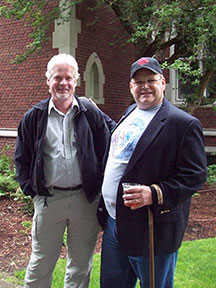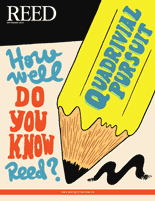
IRIS login | Reed College home Volume 93, No. 3: September 2014
Letters

Science, Knowledge, and History
First, a thanks. I always read my Reed mag cover to cover. The tidbits and articles are a balm for the mind and soul and transport me back to places where I mull and say “huh” about patterns in the world. Not a very erudite Reedie response, but magical for me nonetheless.
Next, I was instantly awake when I read your article on Prof. Josh Howe’s new book and his research. I, too, trod a long and winding road from chemistry at Reed to low-paying advocacy nonprofits and window washing back to grad school and finally to work in a role that lets me build bridges between scientists and their craft and resource managers who are trying to make the best decisions they can. In the process, I learned a lot about how science works in society outside academic communities, and have come to believe that there is a huge chasm between the way scientists are taught to see themselves (all knowledge is good and helpful, and we are creating knowledge), and how scientists are perceived in resource management wars like Howe’s climate change story (driven by self-interest in the form of getting funding to pursue curiosity-driven work).
I am very glad to see that Reed has someone on the faculty who is digging into the role of formalized knowledge in our society. An examined life makes great citizens, but I think the jury is still out on how well formalized knowledge works as guidance at a broader level. I guess the faith/reason dichotomy is still alive. Can I rewind the clock and change my major?

Safe but Not Sound
The March issue of Reed offered an interesting juxtaposition of statements.
In the feature on Emilio Pucci ’37, “Thinker, Tailor, Soldier, Spy,” we read how 78 years ago President Dexter Keezer accepted Pucci as a student in return for his coaching the ski team and other duties, despite Pucci’s espousal of Italian fascism, which he defended in his thesis. In Keezer’s view, however, an outspoken fascist woud “enliven our campus in an intellectually stimulating way.”
Meanwhile, an editorial response to letters in the same issue proclaimed Reed’s new commitment to “a safe and supportive educational environment.” But anyone who has worked in academia, as I have, knows that the word “safe” today does not mean just physically safe but increasingly means “safe from provocative and challenging ideas.”
Poor naive President Keezer! In today’s academic world he would be ground down like hamburger. This is the world in which a respected liberal arts school such as Brandeis can invite as commencement speaker the activist for Muslim women Ayaan Hirsi Ali, only to disinvite her after a few students protested that she was “offensive.”
Let’s imagine a reborn Emilio Pucci, stranded in Portland and approaching Reed College for admission. Imagine him as an enthusiastic member of the Northern League (Lega Nord), a controversial Italian political party often accused of fascist leanings.
Would his presence be seen as “intellectually stimulating” in 2014? Or would the admission door be slammed in his face?
Editor's Note: You raise a vital point that is the subject of much debate on campuses nationwide: what kinds of statements cross the line from offensive to unacceptable? I will not venture an answer, except to say that in this particular case I used the word “safe” in its boring, conventional sense. Based on the conversations I overhear in the Quad, Reed students still encounter (and generate) provocative and challenging ideas by the barrel. As to Pucci, I think the answer would depend more on his essay than his dossier.

Etched into the Rocks
I am the parent of a Reed student and was born and raised in Portland. In reading the article on Thomas Lamb Eliot in the June issue, I learned a couple of details about Mr. Eliot that indicate a solution to a mystery that has puzzled me for many years. My family has owned a cabin in Rockaway on the Oregon coast since the ’50s. I have hiked the trail to the top of Mount Neahkahnie countless times over the years. On one of those hikes, probably in the ’70s, at the top of the mountain I discovered, etched deeply into the rocks, this inscription: “T.S.+ M.E. Eliot, 1925.” I at first thought it might have been the poet himself, but since he was, as far as I know, nowhere near the Oregon coast in 1925 and did not have a wife with initials “M.E.,” I remained baffled by the inscription. Two items in Mr. Hernandez’s article point toward an answer to this little mystery: 1) that there were eight children in the Eliot family, and 2) that they had a home or cabin at Neahkahnie around 1925. The final link will be to find out the names of Eliot’s children, which I’m sure I can accomplish with a little research. Please pass on my gratitude to Mr. Hernandez.

Kingdom for a Hearse
Nisma Elias’ article “Looking Back at Freedom Summer” in June describes the small cadre of idealistic Reed students who went to the Deep South to register black voters during the Freedom Summer of 1964, including Ray Raphael ’65. There is one small and enjoyable error in Nisma’s story, when she quotes Ray as saying, “I drove around in a very noticeable black Pontiac Hurst...”
Ray, in fact, did not drive a “hurst,” but rather, a hearse. Talk about noticeable! It was a huge, heavy, and supremely improbable thing, quite well known on the Reed campus. His car just exuded contempt for middle-class propriety: instead of the dignified carriage of the deceased, Ray transported, in high style, many very-much-alive Reedies on their way to one political confrontation or another.
I know that Ray went on to become a successful writer about American politics and history, but I also wonder what became of his famous hearse, one of the most notable symbols of Reed’s endearing weirdness during the ’60s.
In response to Gray’s inquiry about the fate of my ’54 Pontiac hearse, here is its saga.
I purchased it for only $300, quite a steal for a car with only 3,000 miles on it—not just little-old-ladies-going-to-church miles, but dead-ladies-and-gents-inching-slowly-from-church-to-cemetery miles. Perhaps the most notable adventure during its tenure at Reed was being turned back at the Canadian border by guards who just didn’t like the feel of black and white teenagers entering their country, sprawled in the back of a hearse. I told them we were sponsored by the U.S. government, which was true—we were on a field trip from Reed’s pioneering Upward Bound program—but that made no difference. They would have none of our strange crew in Canada.
In 1968 my hearse carried me to San Francisco for my first teaching job. The hearse did not appreciate the steep hills, and it could find no rest unless we found adjacent parking spaces. The following spring we ventured to the woods of California’s “Lost Coast,” 200 miles to the north. Those dirt roads were no more to the hearse’s liking than were the streets of San Francisco, so we made a deal: I would park her in a nice, comfortable spot—put her to pasture, as it were—and she would be “home” to myself and my partner at the time, Sandy Clark Goodrick ’66. The spacious rear compartment, lined with blue velvet and accustomed to prone bodies in deep sleep, made a luxurious bedroom, and the front seat served as a kitchen of sorts.
So there she sat, at rest. Over the next few years she offered herself as home to various young folks in need of cover. She befriended a neighbor, the volunteer fire department’s truck that moved in across her dirt driveway. A few tenants later, vacant, she grew a garden of berry bushes around her. Only later, a decade or so, did she give up the ghost, hauled away to a junkyard.
What I like about her story is how she meshes with the history of the times, from political activist in the ’60s to back-to-the-land hippie in the ’70s. She was very tuned in, as we said in the day.

Remembering Mike Owren ’77

Mike Owren ’77 (left) and Bill Nicholson ’78 (“who has since lost 50 pounds, I would have you know!”) at Reunions 2008.
I was surprised and saddened to read of the untimely death of Mike/Magne Owren ’77. Mike lived a couple of rooms down from me in McNaughton 3 during his first year at Reed. As any Reedie can report, that first year can be a tough one. Mike was always a bright light during the rainy darkness of that first Oregon winter. He played a very fine acoustical guitar. While he wasn’t loud, when he spoke, he had something worthwhile to say, sometimes expressed in so dry a wit that it went over the heads of his audience. A gentle soul, Mike went on to have an innovative career as a psychologist, making unique contributions in the area of communications between and among animals and humans. I last spent time with him at the 2008 Reunions, and he was his same old self. Then, as always, Mike was amused by the world around him, with a kind word for all, and his eyes focused on the skies above.

Canyon Sage
I knew there would be some good reason for my deciding to read every article in the June issue of Reed. On page 45 is an interesting article (“Gale Dick ’50: Canyon Sage”) about a fellow member of what was at that time called the Portland Junior Symphony. In the early ’40s, Gale Dick was in the first violin section and I played in the viola section. I have no memory of our ever speaking to each other, but I knew who he was. That knowledge came to me when Maestro Gershkovitch announced during a rehearsal that Gale had won a Rhodes scholarship. For a 13-year old first-generation American, that was pretty heady stuff. And my winning a one-year scholarship to Reed, three years later, sweetened the whole idea of education. Thank you for Reed—the college and the magazine.
Editor's Note: We are sad to report that Gale shortly after this article was published. Look for an obituary in a future issue of Reed.

LATEST COMMENTS
steve-jobs-1976 I knew Steve Jobs when he was on the second floor of Quincy. (Fall...
Utnapishtim - 2 weeks ago
Prof. Mason Drukman [political science 1964–70] This is gold, pure gold. God bless, Prof. Drukman.
puredog - 1 month ago
virginia-davis-1965 Such a good friend & compatriot in the day of Satyricon...
czarchasm - 4 months ago
John Peara Baba 1990 John died of a broken heart from losing his mom and then his...
kodachrome - 7 months ago
Carol Sawyer 1962 Who wrote this obit? I'm writing something about Carol Sawyer...
MsLaurie Pepper - 8 months ago
William W. Wissman MAT 1969 ...and THREE sisters. Sabra, the oldest, Mary, the middle, and...
riclf - 10 months ago